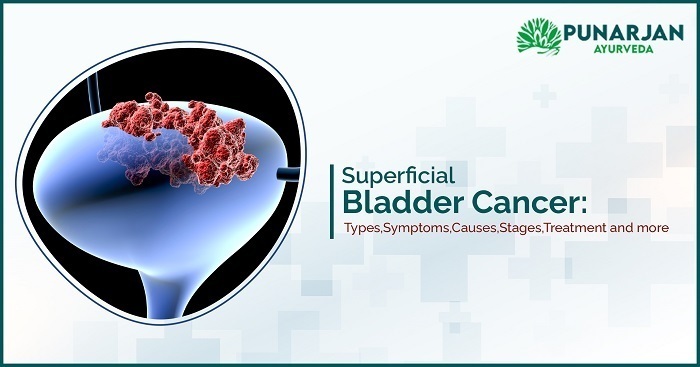
What is Superficial Bladder Cancer?
Superficial Bladder cancer is a type of cancer that starts in the Bladder lining, and it will not spread further. The other name for Superficial Bladder Cancer is known as non-muscle-invasive Bladder Cancer. And it is the most common type of Bladder Cancer, and nearly 75% are new cases of Superficial Bladder Cancer.
What are types Of Bladder Cancer?
There are two types of Superficial Bladder Cancer:
1) Papillary carcinoma
2) Flat carcinoma
Papillary carcinoma: Papillary Cancer, which grows thinner like projections, usually grows to the center of the Bladder, and it is known as Non- invasive papillary Cancer. A slow-growing non-invasive papillary does not refer to PUNLMP or urothelial neoplasm of the lower malignant Potential.
Flat carcinoma: it does not grow towards the center of the Bladder but remains in the inner part of the Bladder cells. It is known as flat Cancer in situ (CIS) or non-invasive flat cancer.
Either if the cancer cells grow deeper into the bladder, it is called transitional cancer or carcinoma. Nearly 90% of bladder cancer is known as transitional cells cancer or known urothelial cancer. This type of cancer starts in the urothelial cells, which lay inside your Bladder, and the same type of cells can also be found in your urinary tract.
What are the symptoms of Superficial Bladder Cancer?
Some symptoms of Superficial Bladder Cancer are:
1) Painful Urination
2) Frequent urination
3) Blood in urine
4) Feeling tough while urinating when your bladder is full.
5) Burning sensation while urination
6) Weak urination
What Causes Superficial Bladder Cancer?
Superficial Bladder Cancer is one of the fourth most leading causes of cancer. It is one of the first malignancies in which carcinogens are being recognized, as it is one of the most important reasons to cause cancer. And talking about the current situation, smoking cigarettes is one of the most common ways to cause superficial bladder cancer.
What are the causes of Superficial Bladder cancer?
- Smoking
- Race
- Sex
- Chemicals
- Cyclophosphamide
- Chronic bladder inflammation
- Arsenic
- Age
- Genetics
- Family history
What are the risk factors of Superficial Bladder Cancer?
- Nearly 70,000 new cases are of superficial Bladder cancer every year. Male – Female radio is about 3:1, and the chance of developing superficial bladder cancer risk increases with age.
- The most common risk factor for causing superficial bladder cancer is smoking.
- Try to abuse phenacetin and analgesic.
- Use of cyclophosphamide for the long term can be a suppressant.
- Having chronic irritation due to a parasitic disease called schistosomiasis.
- Long-term chronic irritation is called catheterization
How is Superficial Bladder Cancer Diagnosed?
- Urine test (urine cytology):
- CT urogram:
- Retrograde pyelogram:
- Cystoscopy.
Biopsy-After the Biopsy test confirms that bladder cancer, the other tests might be used to determine that cancer has spread or not; the other test may include:
- CT scan
- MRI test
- Chest X-ray
- Bone scan
If cancer has not spread to the outer line of the bladder, then the diagnosis is known as superficial or stage 0 bladder cancers.
What are the survival rates for Superficial Bladder Cancer?
Can compare the survival rate for superficial bladder cancer with people with the same type & stage of Bladder cancer in people overall. If a 5-year survival rate is there for a specific stage of superficial bladder cancer, then the survival rate is 90%. That means people who are at that stage are, on average. Doctors can tell you how long you’re going to live, but they will help you better understand how likely it is that our treatment will be successful.
How is Superficial Bladder Cancer treated and different stages of treatment?
There are 3 stages of superficial Bladder cancer they are called: can compare the survival rate for superficial bladder cancer
- Tis
- Ta
- T1
Tis: Tis cancer is also known as CIS, which means at very early high-grade cancer cells, are only there in the innermost layer of the bladder lining. It is also known as non-invasive cancer cells, and these cells moist the tissues which line in your body organ. They can grow more than one part of the bladder lining, and it will look like flat velvety patches can be seen under the microscope.
Ta and T1: this is only cancer that lies in the innermost layer of the bladder lining (Ta), or it starts growing into the connective tissues of the bladder lining.
What is Treatment for Superficial Bladder Cancer?
- Stages of your superficial bladder cancer will help your doctor decide which type of treatment you need, and the treatment depends on your type of cancer.
- Your risk of growing cancer will be high, low, and intermediate.
Another treatment for Superficial Bladder Cancer is:
- Surger
- Chemotherapy
- Taking vaccination called BCG into your Bladder
Superficial Bladder cancer can be recurring, so you should always be careful while monitoring. Your doctor will also monitor you or recommend you for cystoscopy every 3 to 6 months for several years.
How can we prevent Superficial Bladder Cancer?
- Avoid smoking
- Stop second hand cigarette smoke
- Avoid other carcinogenic chemicals
- Drink more water
- Eat lots of vegetables and fruit
What are the facts about Superficial Bladder Cancer?
• Superficial Bladder Cancer is the most common type of cancer, and the symptoms of Bladder Cancer are bleeding in the urine, known as hematuria.
• Smoking is the major risk factor of superficial Bladder cancer, the risk factor increasing by 3 to 4 times more likely to get the disease.
• There are two types of sub-divisions of superficial Bladder Cancer known as non- Invasive or superficial and Invasion.
• Treatment for superficial Bladder cancer is known as Transurethral Resection of the Bladder Tumor (TURBT); it removes the tumor from the Bladder through Urethra and provides instructions to both stages and grades of the tumor.
• Superficial Bladder cancer is staged and classified to the extent of the spread of cancer and grades how abnormal cells appear below the microscope to determine the treatment for patients.
• T1 Tumor has a high risk of recurrence and progression and might need additional treatment in the form of chemotherapy or BCG instillation in the bladder.
• Radical Cystectomy is a bladder removal that is an option for patients who are not responding to other treatments.
• Risk factor for superficial bladder cancer increases with age, and it is more common in men than in women.
• Can diagnose superficial bladder cancer in many ways. Your doctor will recommend a complete medical history, and they may tell you to perform a rectal or vaginal test to check for tumors.
Living and Managing with Superficial Bladder Cancer?
Living and managing superficial Bladder cancer is taking regular follow-up, and treatment is generally successful. Flat Cancer is recurring, and it can become more invasive. The survival rate for superficial Bladder cancer is about 93%.
FAQs for Superifical Bladder Cancer
1. Is superficial bladder cancer curable?
Superficial Bladder cancer is taking regular follow-up, and treatment is successfully cured. Superficial bladder cancer can be found in the bladder or any part of the urinary system.
2. Can superficial bladder cancer spread?
Superficial Bladder cancer can spread in the bladder’s lining, and it does not spread beyond it.
3. What is the most aggressive type of bladder cancer?
Sometimes tumors can be high or low in grade. High-grade tumor cells are very abnormally grown and are poorly organized and are most aggressive and grow into the bladder muscle.
4. How long will you live if you have bladder cancer?
Can compare the survival rate for bladder cancer with people with the same type & stage of Bladder cancer in people overall. If a 5-year survival rate is there for a specific stage of superficial bladder cancer, then the survival rate is 90%. can compare the survival rate for bladder cancer
5. Is bladder cancer curable if caught early?
Bladder cancer is diagnosed at a very early stage, and when they are at the high stage, it can be treatable. But sometimes, the early stage of bladder cancer can come after treating successfully. So people need to do regular follow up and test as per your doctor’s suggestion.
6. Does bladder cancer spread fast?
Those who have High-grade bladder cancer are likely to grow and spread quickly, and it is life-threatening. High-grade cancer needs to be with chemotherapy, radiation, or surgery
7. What are the symptoms of late-stage bladder cancer?
Some symptoms of Superficial Bladder Cancer are:
•Painful Urination
•Frequent urination
•Blood in urine
•Feeling tough while urinating when your bladder is full.
•Burning sensation while urination
•Weak urination
8. Does bladder cancer always return?
A bladder cancer cell can occur in any part of the body. Though cells recurring back are uncommon among the people who are already treated for Bladder cancer in most cases of bladder cancer recurrence can be treated effectively.
9. What part of the body does bladder cancer generally affect?
An overall view bladder cancer cell grows abnormally and they are uncontrollably growing cells in the lining of the bladder. These cancer cells start to affect the normal functioning of the bladder and they can spread to the surrounding organs of the body.
10. Is blood in urine an early sign of cancer?
In some cases of cancer blood can be found in urine it is known as hematuria this is the first sign of bladder cancer and this blood is enough to change the color of the urine to pink, orange, and often dark red in color.



